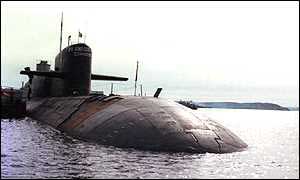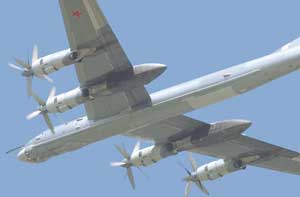 MOSCOW
- A technical glitch thwarted the launch of Russian
ballistic missiles in the Barents Sea on Tuesday during
naval maneuvers overseen by President Vladimir Putin,
who watched the massive exercise while decked out in
naval officer's garb aboard a nuclear submarine. MOSCOW
- A technical glitch thwarted the launch of Russian
ballistic missiles in the Barents Sea on Tuesday during
naval maneuvers overseen by President Vladimir Putin,
who watched the massive exercise while decked out in
naval officer's garb aboard a nuclear submarine.
The failed launch - part of an exercise described as the
largest show of Russian military might in more than 20
years - marred an event apparently aimed at playing up
Putin's image as a leader attempting to restore the
country's military power and global clout.
Putin, who is expected to easily win the presidential
election March 14, went to the Barents Sea on board the
giant Arkhangelsk submarine to observe maneuvers set to
involve numerous missile launches and flights of
strategic bombers.
 |
| Russian
Arkhangelsk submarine |
But the ambitious exercise hit a snag when one of the ballistic
missiles failed to launch as scheduled from another submarine, the Novomoskovsk, a government official said on condition of
anonymity. The official said the automatic safety system
blocked the launch for unspecified reasons. The
Russian website gazeta.ru said the other missile blew up
shortly after firing.
A Defense Ministry spokesman refused to comment. And
Russian state-run television channels, which are
lavishly covering the daily activities of Putin ahead of
the election, did not report the failed launch.
But the event became a hot topic for Russian analysts
and military figures.
"The failed launch has shown the gap between the
real condition of the Russian military and the ambitions
and muscle-flexing of the Russian leadership," said
Yevgeny Volk, the head of the Heritage Foundation's
Moscow office.
 |
| Russian
Novomoskovsk submarine |
Retired Capt. Igor Kurdin, who in the early 1990s served
as captain of the Novomoskovsk, said a technical problem
or a crew mistake might have caused the failure.
"It's very annoying that it happened in front of
the commander in chief," Kurdin, who did not
witness the exercise, told The Associated Press.
"I'm sure that the crew was getting ready for the
launch very thoroughly in such circumstances."
There were differing accounts of what happened.
 |
| Russian RSM-54
SLBM nuclear missile. NATO code-named SS-N-23. |
The Interfax and ITAR-Tass news agencies said the
Novomoskovsk had been scheduled to launch two RSM-54
missiles in succession at a practice target on the
Kamchatka Peninsula in Russia's Far East.
They quoted an unidentified Northern Fleet officer as
saying a satellite signal blocked the missile launch
from Novomoskovsk, a Delta IV-class submarine.
An online news outlet, gazeta.ru, said the missile
suffered an engine failure and disintegrated immediately
after its launch.
Despite earlier official statements about the scheduled
launch, the Russian navy's chief, Adm. Vladimir
Kuroyedov, was shown later on NTV television insisting
the navy had planned only imitation
"electronic" launches, both of which he said
were performed successfully.
 Putin boarded the Arkhangelsk late Monday, putting on
naval officer's garb complete with white scarf and
gloves. He inspected the ship, discussed the exercise's
plan with the top brass and dined with the crew. Putin boarded the Arkhangelsk late Monday, putting on
naval officer's garb complete with white scarf and
gloves. He inspected the ship, discussed the exercise's
plan with the top brass and dined with the crew.
"Putin likes playing these military games and
donning uniforms," Volk said in a telephone
interview. "It was part of the election campaign,
an attempt to win the military and nationalist
votes."
Putin visited another Northern Fleet nuclear submarine
in April 2000, just about four months before the sinking
of the Kursk nuclear submarine in the Barents Sea. That
catastrophe killed all 118 men on board and cut into the
Russian navy's prestige.
After returning to the Arctic base, Putin traveled to
the northern launch pad of Plesetsk. There, he was
expected to watch the launch of a Topol intercontinental
ballistic missile, the Kommersant newspaper reported
Tuesday.
 |
Russian Tu-95
Bear Bomber
A view from an F-15E from Alaska |
The exercises, which began in late January, reached
their peak Tuesday when 13 Northern Fleet ships and
seven nuclear submarines, including the Arkhangelsk,
went out to sea, practicing launches of air defense
missiles, according to Channel One television. Several
Tu-95 strategic bombers also participated, test-firing
cruise missiles.
The Russian military has dismissed media reports that
the exercises closely resemble Soviet-era simulations of
an all-out nuclear war with the United States, saying
the maneuvers are not directed against any specific
country.
At the same time, the military said the exercises
reflect Moscow's concerns about U.S. plans to develop
new types of nuclear weapons. It has not said when the
exercises will end.
|